Broadway Theatres
Item set
- Title
- Broadway Theatres
Items
-
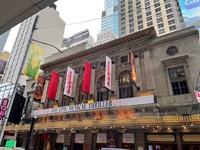 Lunt-Fontanne Theatre Built for illustrious producer Charles B. Dillingham, The Globe Theatre, named after Shakespeare’s theatre in England opened with a production of the Old Town. It had a large oval panel that could be opened to enable the theatre to stay cool and open during the summer. Because the stock market crash of 1929 caused Dillingham to lose the theatre, The Globe was converted into a movie house in 1932 (https://www.playbill.com/venue/view-more?venue=00000150-aacd-d8be-af71-ffef1887000c). It was operated by the Brant chain as a movie house until 1957 (https://en.wikipedia.org/wiki/Lunt-Fontanne_Theatre). In 1957, the theatre was purchased by City Playhouses. It was renovated by the firm of Roche and Roche and reopened as a live theatre venue. The only surviving facade is on 46th street, the original carriage entrance (https://en.wikipedia.org/wiki/Lunt-Fontanne_Theatre). It was renamed in honor Alfred Lunt and Lynn Fontanne, America's foremost husband-wife acting duo at the time. The couple starred in the first production of the reopened theatre, The Visit (https://broadwaydirect.com/theatre/lunt-fontanne-theatre/). The Lunt-Fontanne has been operated by the Nederlander Organization since 1973 (https://en.wikipedia.org/wiki/Lunt-Fontanne_Theatre). Notable productions: Ziegfeld Follies, The Visit, A Funny Thing Happened on the Way to the Forum, Hello, Dolly!, The Wiz, Beauty and the Beast, and The Little Mermaid (https://en.wikipedia.org/wiki/Lunt-Fontanne_Theatre). Number of seats: 1,443 (https://www.playbill.com/venue/lunt-fontanne-theatre-vault-0000000158). The facade is a New York City landmark (https://en.wikipedia.org/wiki/Lunt-Fontanne_Theatre).
Lunt-Fontanne Theatre Built for illustrious producer Charles B. Dillingham, The Globe Theatre, named after Shakespeare’s theatre in England opened with a production of the Old Town. It had a large oval panel that could be opened to enable the theatre to stay cool and open during the summer. Because the stock market crash of 1929 caused Dillingham to lose the theatre, The Globe was converted into a movie house in 1932 (https://www.playbill.com/venue/view-more?venue=00000150-aacd-d8be-af71-ffef1887000c). It was operated by the Brant chain as a movie house until 1957 (https://en.wikipedia.org/wiki/Lunt-Fontanne_Theatre). In 1957, the theatre was purchased by City Playhouses. It was renovated by the firm of Roche and Roche and reopened as a live theatre venue. The only surviving facade is on 46th street, the original carriage entrance (https://en.wikipedia.org/wiki/Lunt-Fontanne_Theatre). It was renamed in honor Alfred Lunt and Lynn Fontanne, America's foremost husband-wife acting duo at the time. The couple starred in the first production of the reopened theatre, The Visit (https://broadwaydirect.com/theatre/lunt-fontanne-theatre/). The Lunt-Fontanne has been operated by the Nederlander Organization since 1973 (https://en.wikipedia.org/wiki/Lunt-Fontanne_Theatre). Notable productions: Ziegfeld Follies, The Visit, A Funny Thing Happened on the Way to the Forum, Hello, Dolly!, The Wiz, Beauty and the Beast, and The Little Mermaid (https://en.wikipedia.org/wiki/Lunt-Fontanne_Theatre). Number of seats: 1,443 (https://www.playbill.com/venue/lunt-fontanne-theatre-vault-0000000158). The facade is a New York City landmark (https://en.wikipedia.org/wiki/Lunt-Fontanne_Theatre). -
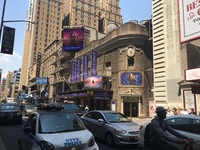 Broadhurst Theatre Built and named for George H. Broadhurst, the Anglo-American manager and playwright (1866-1952), in partnership with the Shubert brothers, The Broadhurst opened with a production of George Bernard Shaw's Misalliance. Broadhurst had previously managed theatres in Milwaukee, Baltimore, and San Francisco before opening his New York theatre (https://www.playbill.com/venue/view-more?venue=00000150-aacd-d8be-af71-ffef189b0001). The Shuberts gained full ownership of the theatre in 1929 and have operated the Broadhurst ever since (https://en.wikipedia.org/wiki/Broadhurst_Theatre). It was developed concurrently to the Gerald Schoenfeld Theatre (then known as the Plymouth) by Krapp as his first independent commissions. They were designed as mirror images or each other, opening only two weeks apart (https://shubert.nyc/theatres/broadhurst/). It was renovated in 1985 by the firm of Johansen-Bhavnan for $2 million (https://en.wikipedia.org/wiki/Broadhurst_Theatre). Notable productions: Hold Everything!, Fiorello!, Cabaret, Grease, Kiss of the Spider Woman, Les Misérables, and Mamma Mia! (https://en.wikipedia.org/wiki/Broadhurst_Theatre). Number of seats: 1163 (https://www.playbill.com/venue/broadhurst-theatre-vault-0000000061). Both the facade and the auditorium interior are New York City landmarks (https://en.wikipedia.org/wiki/Broadhurst_Theatre).
Broadhurst Theatre Built and named for George H. Broadhurst, the Anglo-American manager and playwright (1866-1952), in partnership with the Shubert brothers, The Broadhurst opened with a production of George Bernard Shaw's Misalliance. Broadhurst had previously managed theatres in Milwaukee, Baltimore, and San Francisco before opening his New York theatre (https://www.playbill.com/venue/view-more?venue=00000150-aacd-d8be-af71-ffef189b0001). The Shuberts gained full ownership of the theatre in 1929 and have operated the Broadhurst ever since (https://en.wikipedia.org/wiki/Broadhurst_Theatre). It was developed concurrently to the Gerald Schoenfeld Theatre (then known as the Plymouth) by Krapp as his first independent commissions. They were designed as mirror images or each other, opening only two weeks apart (https://shubert.nyc/theatres/broadhurst/). It was renovated in 1985 by the firm of Johansen-Bhavnan for $2 million (https://en.wikipedia.org/wiki/Broadhurst_Theatre). Notable productions: Hold Everything!, Fiorello!, Cabaret, Grease, Kiss of the Spider Woman, Les Misérables, and Mamma Mia! (https://en.wikipedia.org/wiki/Broadhurst_Theatre). Number of seats: 1163 (https://www.playbill.com/venue/broadhurst-theatre-vault-0000000061). Both the facade and the auditorium interior are New York City landmarks (https://en.wikipedia.org/wiki/Broadhurst_Theatre). -
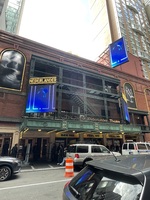 Nederlander Theatre Built for Walter C. Jordan, notable theatrical agent, the National Theatre reportedly cost $950,000 and opened with a production of Swords. While it was not when it opened, it is now the southernmost Broadway theater in the Theater District (https://www.playbill.com/venue/view-more?venue=00000150-aacd-d8be-af71-ffef18850006). Operated by the Shuberts since it opened, they purchased the theatre outright from Jordan in 1927. In 1956 the Shuberts, who owned half of the theatres in New York City, were forced to sell the National as part of the ruling of a US federal antitrust case against them. Songwriter, producer, and millionaire art collector, Bill Rose purchased, renovated, and renamed the theatre after himself (https://en.wikipedia.org/wiki/Nederlander_Theatre). In 1978 it was purchased by the Nederlanders and the Cooney-Marsh Organization, renovated, and renamed the Trafalgar. The theatre was renamed for a final time in 1980 to the Nederlander Theatre in honor of the late theatre owner David Tobias Nederlander (https://www.playbill.com/venue/view-more?venue=00000150-aacd-d8be-af71-ffef18850006). The Nederlander operated as a live theatre venue throughout its history. Notable productions: Cyrano de Bergerac, Inherit the Wind, Private Lives, Julius Caesar, King Lear, Who’s Afraid of Virginia Woolf, Lena Horne: The Lady and Her Music, and Rent (https://en.wikipedia.org/wiki/Nederlander_Theatre). Number of seats: 1,168 seats (https://www.playbill.com/venue/nederlander-theatre-vault-0000000071). The Nederalander was denied both exterior and interior landmark status in 1987 (https://en.wikipedia.org/wiki/Nederlander_Theatre).
Nederlander Theatre Built for Walter C. Jordan, notable theatrical agent, the National Theatre reportedly cost $950,000 and opened with a production of Swords. While it was not when it opened, it is now the southernmost Broadway theater in the Theater District (https://www.playbill.com/venue/view-more?venue=00000150-aacd-d8be-af71-ffef18850006). Operated by the Shuberts since it opened, they purchased the theatre outright from Jordan in 1927. In 1956 the Shuberts, who owned half of the theatres in New York City, were forced to sell the National as part of the ruling of a US federal antitrust case against them. Songwriter, producer, and millionaire art collector, Bill Rose purchased, renovated, and renamed the theatre after himself (https://en.wikipedia.org/wiki/Nederlander_Theatre). In 1978 it was purchased by the Nederlanders and the Cooney-Marsh Organization, renovated, and renamed the Trafalgar. The theatre was renamed for a final time in 1980 to the Nederlander Theatre in honor of the late theatre owner David Tobias Nederlander (https://www.playbill.com/venue/view-more?venue=00000150-aacd-d8be-af71-ffef18850006). The Nederlander operated as a live theatre venue throughout its history. Notable productions: Cyrano de Bergerac, Inherit the Wind, Private Lives, Julius Caesar, King Lear, Who’s Afraid of Virginia Woolf, Lena Horne: The Lady and Her Music, and Rent (https://en.wikipedia.org/wiki/Nederlander_Theatre). Number of seats: 1,168 seats (https://www.playbill.com/venue/nederlander-theatre-vault-0000000071). The Nederalander was denied both exterior and interior landmark status in 1987 (https://en.wikipedia.org/wiki/Nederlander_Theatre). -
 Al Hirschfeld Theatre Built by and named after Martin Beck, the vaudeville mogul, the Martin Beck Theatre opened with performances of Madame Pompadour. It is the westernmost Broadway Theatre and the only theatre designed in the Byzantine style in the US. The theatre stayed in the Beck family until 1966 when it was sold to Jujamcyn Theatres (https://www.playbill.com/venue/view-more?venue=00000150-aacd-d8be-af71-ffef18950004). It was renovated in 1996 and again in 2003 (https://en.wikipedia.org/wiki/Al_Hirschfeld_Theatre). It remained a live theatre venue throughout its history. In 2003 it was renamed in honor of the late, great American caricaturist and illustrator Al Hirschfeld, known for his fantastic black and white portraits of celebrities and Broadway stars (https://www.alhirschfeldtheatre.org). Notable productions: The Teahouse of the August Moon, Bye Bye Birdie, Dracula, Into the Woods, Guys and Dolls, Kiss Me, Kate, Hair, and Kinky Boots (https://en.wikipedia.org/wiki/Al_Hirschfeld_Theatre). Number of seats: 1302 (https://www.playbill.com/venue/al-hirschfeld-theatre-vault-0000000268). Both the facade and the interior are New York City landmarks (https://en.wikipedia.org/wiki/Al_Hirschfeld_Theatre).
Al Hirschfeld Theatre Built by and named after Martin Beck, the vaudeville mogul, the Martin Beck Theatre opened with performances of Madame Pompadour. It is the westernmost Broadway Theatre and the only theatre designed in the Byzantine style in the US. The theatre stayed in the Beck family until 1966 when it was sold to Jujamcyn Theatres (https://www.playbill.com/venue/view-more?venue=00000150-aacd-d8be-af71-ffef18950004). It was renovated in 1996 and again in 2003 (https://en.wikipedia.org/wiki/Al_Hirschfeld_Theatre). It remained a live theatre venue throughout its history. In 2003 it was renamed in honor of the late, great American caricaturist and illustrator Al Hirschfeld, known for his fantastic black and white portraits of celebrities and Broadway stars (https://www.alhirschfeldtheatre.org). Notable productions: The Teahouse of the August Moon, Bye Bye Birdie, Dracula, Into the Woods, Guys and Dolls, Kiss Me, Kate, Hair, and Kinky Boots (https://en.wikipedia.org/wiki/Al_Hirschfeld_Theatre). Number of seats: 1302 (https://www.playbill.com/venue/al-hirschfeld-theatre-vault-0000000268). Both the facade and the interior are New York City landmarks (https://en.wikipedia.org/wiki/Al_Hirschfeld_Theatre). -
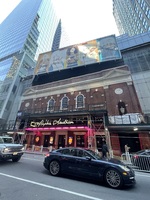 Stephen Sondheim Theatre Built by and named for Henry Miller, the actor and producer, Henry Miller's Theatre, with a 950 seat capacity, opened with a production of The Fountain of Youth. When Miller died in 1926, his son Gilbert Miller took over operation and it remained in the family until 1968. The theatre was sold first to the Nederlanders in 1968, then to Seymour Durst in 1969. In 1970 the theatre stopped showing live theatre and started showing films. Initially it screened movies, but in 1972 it served as a porn theater. In 1978 the theatre became a disco called Xenon (https://www.playbill.com/venue/view-more?venue=00000150-aacd-d8be-af71-ffef1886000b). The venue returned to showing live theatre in 1998 when it was renovated, reopened, and rechristened the Kit Kat Cub with a Tony award–winning production of Cabaret (https://en.wikipedia.org/wiki/Stephen_Sondheim_Theatre). All but the brick facade was demolished in 2004 for reconstruction by Cook + Fox as part of the Bank of America Tower. The new theatre was constructed underground with the top balcony at street level in contrast to almost every other Broadway theatre with the orchestra at street level (https://www.playbill.com/venue/view-more?venue=00000150-aacd-d8be-af71-ffef1886000b). After the completion of construction, Henry Miller’s Theatre reopened in 2009 as the first LEED-certified Broadway theatre, raising the bar for environmentally sustainable construction of performing arts venues (https://www.roundabouttheatre.org/theatres-and-venues/stephen-sondheim-theatre/). In 2010, it was renamed the Stephen Sondheim Theatre in honor of the legendary composer and lyricist’s 80th birthday. When a theatre in London's West End was named after Sondheim in 2019, he became the only then-living person to have theaters named after them in both New York and London (https://www.newyorktheatreguide.com/venues/stephen-sondheim-theatre). Notable productions: La, La, Lucille, Journey's End, Our Town, Dear Ruth, Cabaret, Urinetown, and Beautiful: The Carole King Musical (https://en.wikipedia.org/wiki/Stephen_Sondheim_Theatre#Notable_productions). Number of seats: 1026 (https://www.playbill.com/venue/stephen-sondheim-theatre-vault-0000000184). The facade is protected as a city landmark by the New York City Landmarks Preservation Commission (https://en.wikipedia.org/wiki/Stephen_Sondheim_Theatre).
Stephen Sondheim Theatre Built by and named for Henry Miller, the actor and producer, Henry Miller's Theatre, with a 950 seat capacity, opened with a production of The Fountain of Youth. When Miller died in 1926, his son Gilbert Miller took over operation and it remained in the family until 1968. The theatre was sold first to the Nederlanders in 1968, then to Seymour Durst in 1969. In 1970 the theatre stopped showing live theatre and started showing films. Initially it screened movies, but in 1972 it served as a porn theater. In 1978 the theatre became a disco called Xenon (https://www.playbill.com/venue/view-more?venue=00000150-aacd-d8be-af71-ffef1886000b). The venue returned to showing live theatre in 1998 when it was renovated, reopened, and rechristened the Kit Kat Cub with a Tony award–winning production of Cabaret (https://en.wikipedia.org/wiki/Stephen_Sondheim_Theatre). All but the brick facade was demolished in 2004 for reconstruction by Cook + Fox as part of the Bank of America Tower. The new theatre was constructed underground with the top balcony at street level in contrast to almost every other Broadway theatre with the orchestra at street level (https://www.playbill.com/venue/view-more?venue=00000150-aacd-d8be-af71-ffef1886000b). After the completion of construction, Henry Miller’s Theatre reopened in 2009 as the first LEED-certified Broadway theatre, raising the bar for environmentally sustainable construction of performing arts venues (https://www.roundabouttheatre.org/theatres-and-venues/stephen-sondheim-theatre/). In 2010, it was renamed the Stephen Sondheim Theatre in honor of the legendary composer and lyricist’s 80th birthday. When a theatre in London's West End was named after Sondheim in 2019, he became the only then-living person to have theaters named after them in both New York and London (https://www.newyorktheatreguide.com/venues/stephen-sondheim-theatre). Notable productions: La, La, Lucille, Journey's End, Our Town, Dear Ruth, Cabaret, Urinetown, and Beautiful: The Carole King Musical (https://en.wikipedia.org/wiki/Stephen_Sondheim_Theatre#Notable_productions). Number of seats: 1026 (https://www.playbill.com/venue/stephen-sondheim-theatre-vault-0000000184). The facade is protected as a city landmark by the New York City Landmarks Preservation Commission (https://en.wikipedia.org/wiki/Stephen_Sondheim_Theatre). -
 Richard Rodgers Theatre Built by brothers Irwin S. and Harry I. Chanin, the Chanin's 46th Street Theatre opened with Is Zat So?(https://v.playbill.com/venue/view-more?venue=00000150-aacd-d8be-af71-ffef18860005). The theatre was leased and operated by the Shuberts when the theatre opened, then purchased outright by them in 1931 and renamed the 46th Street Theatre. After changing ownership several more times between 1945 and 1978, the Nederlander Organization purchased the theatre in 1981 and renamed it in 1990 to honor the legendary composer Richard Rodgers whose shows defined Broadway for more than three decades. It operated as a live theatre venue throughout its history (https://en.wikipedia.org/wiki/Richard_Rodgers_Theatre). Notable productions: Anything Goes, Guys and Dolls, Damn Yankees, How to Succeed in Business Without Really Trying, 1776, Raisin, The Best Little Whorehouse in Texas, Nine, Fences, Lost in Yonkers Chicago, Movin’ Out, In the Heights, and Hamilton (https://broadwaydirect.com/theatre/richard-rodgers-theatre/). Number of seats: 1321 (https://www.playbill.com/venue/richard-rodgers-theatre-vault-0000000085). Both the facade and the auditorium interior are New York City landmarks (https://en.wikipedia.org/wiki/Richard_Rodgers_Theatre).
Richard Rodgers Theatre Built by brothers Irwin S. and Harry I. Chanin, the Chanin's 46th Street Theatre opened with Is Zat So?(https://v.playbill.com/venue/view-more?venue=00000150-aacd-d8be-af71-ffef18860005). The theatre was leased and operated by the Shuberts when the theatre opened, then purchased outright by them in 1931 and renamed the 46th Street Theatre. After changing ownership several more times between 1945 and 1978, the Nederlander Organization purchased the theatre in 1981 and renamed it in 1990 to honor the legendary composer Richard Rodgers whose shows defined Broadway for more than three decades. It operated as a live theatre venue throughout its history (https://en.wikipedia.org/wiki/Richard_Rodgers_Theatre). Notable productions: Anything Goes, Guys and Dolls, Damn Yankees, How to Succeed in Business Without Really Trying, 1776, Raisin, The Best Little Whorehouse in Texas, Nine, Fences, Lost in Yonkers Chicago, Movin’ Out, In the Heights, and Hamilton (https://broadwaydirect.com/theatre/richard-rodgers-theatre/). Number of seats: 1321 (https://www.playbill.com/venue/richard-rodgers-theatre-vault-0000000085). Both the facade and the auditorium interior are New York City landmarks (https://en.wikipedia.org/wiki/Richard_Rodgers_Theatre). -
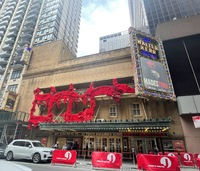 Walter Kerr Theatre Built for the Shuberts as a sister theatre to the Ambassador on West 49th, The Ritz Theatre was built in a record 66 days and is still one of the smaller venues in the Theatre District with less than 1,000 seats. The Ritz Theatre opened with the play Mary Stuart (https://www.playbill.com/venue/view-more?venue=00000150-aacd-d8be-af71-ffef18930006). After a string unsuccessful shows, the theater was leased to the Works Progress Administration's Federal Theatre Project in the late 1930s. It briefly served as a CBS radio broadcasting studio before reverting to a theatre venue hosting live shows between 1942 and 1943. The Ritz again functioned as a studio for NBC then ABC from 1943 until 1965 (https://www.playbill.com/venue/view-more?venue=00000150-aacd-d8be-af71-ffef18930006). The Ritz was abandoned for several years before it returned to showing live theatre between 1971 and 1973. It was renovated for $225,000 in 1971-2 and reopened. After 1973, the Ritz variously operated as a pornographic theater with massage parlor, vaudeville house, children's theater, and poster-storage warehouse. Jujamcyn purchased The Ritz for $1.7 million, took over operations in 1981, and reopened the Ritz as a Broadway Theatre following a $1.5 million renovation. The theater was fully restored for another $1.5 - 1.9 million, reopened again in 1990, and renamed for the eminent critic and playwright, Walter Kerr (ttps://en.wikipedia.org/wiki/Walter_Kerr_Theatre). Notable productions: Angels in America: Millennium Approaches, Angels in America: Perestroika, Love! Valour! Compassion!, Proof, Take Me Out, Doubt, Clybourne Park, A Gentleman's Guide to Love and Murder, and Hadestown (https://en.wikipedia.org/wiki/Walter_Kerr_Theatre). Number of seats: 918 (https://www.playbill.com/venue/walter-kerr-theatre-vault-0000000320). The Walter Kerr was denied both exterior and interior landmark status in 1987 (https://en.wikipedia.org/wiki/Walter_Kerr_Theatre).
Walter Kerr Theatre Built for the Shuberts as a sister theatre to the Ambassador on West 49th, The Ritz Theatre was built in a record 66 days and is still one of the smaller venues in the Theatre District with less than 1,000 seats. The Ritz Theatre opened with the play Mary Stuart (https://www.playbill.com/venue/view-more?venue=00000150-aacd-d8be-af71-ffef18930006). After a string unsuccessful shows, the theater was leased to the Works Progress Administration's Federal Theatre Project in the late 1930s. It briefly served as a CBS radio broadcasting studio before reverting to a theatre venue hosting live shows between 1942 and 1943. The Ritz again functioned as a studio for NBC then ABC from 1943 until 1965 (https://www.playbill.com/venue/view-more?venue=00000150-aacd-d8be-af71-ffef18930006). The Ritz was abandoned for several years before it returned to showing live theatre between 1971 and 1973. It was renovated for $225,000 in 1971-2 and reopened. After 1973, the Ritz variously operated as a pornographic theater with massage parlor, vaudeville house, children's theater, and poster-storage warehouse. Jujamcyn purchased The Ritz for $1.7 million, took over operations in 1981, and reopened the Ritz as a Broadway Theatre following a $1.5 million renovation. The theater was fully restored for another $1.5 - 1.9 million, reopened again in 1990, and renamed for the eminent critic and playwright, Walter Kerr (ttps://en.wikipedia.org/wiki/Walter_Kerr_Theatre). Notable productions: Angels in America: Millennium Approaches, Angels in America: Perestroika, Love! Valour! Compassion!, Proof, Take Me Out, Doubt, Clybourne Park, A Gentleman's Guide to Love and Murder, and Hadestown (https://en.wikipedia.org/wiki/Walter_Kerr_Theatre). Number of seats: 918 (https://www.playbill.com/venue/walter-kerr-theatre-vault-0000000320). The Walter Kerr was denied both exterior and interior landmark status in 1987 (https://en.wikipedia.org/wiki/Walter_Kerr_Theatre). -
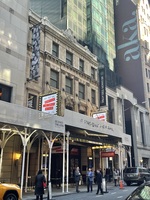 Hudson Theater The Hudson Theatre was built between 1902 and 1903 for producer Henry B. Harris and opened with the show Cousin Kate. When Harris died in the 1912 sinking of the Titanic, his widow, Renee Harris, continued to operate the Hudson, becoming the fist female producer in New York (https://www.playbill.com/venue/view-more?venue=00000150-aacd-d8be-af71-ffef18810003). The Hudson first became a network radio studio for CBS from 1934 to 1937, then an NBC television studio from 1949 to 1960. In the 1960s The Hudson operated as an adult film theater, a movie theater, and the Savoy nightclub. The Theatre was renovated in 1975 and again in 1981 for $1.5 million. The Millennium Times Square New York hotel was built around the theater during the late 1980s, and the Hudson Theatre was renovated for $7 million and utilized as the hotel's event space. The Hudson Theatre was leased by Ambassador Theatre Group, again renovated between 2015 and 2017, and reopened as a Broadway theater in 2017 becoming the 41st Broadway theater and was both the newest and oldest Broadway theater in operation (https://en.wikipedia.org/wiki/Hudson_Theatre). Notable productions: Arsenic and Old Lace, State of the Union, Toys in the Attic, Sunday in the Park with George, 1984, Head Over Heels, Burn This, and Merrily We Roll Along (https://en.wikipedia.org/wiki/Hudson_Theatre). Number of seats: 973 (https://www.playbill.com/venue/hudson-theatre-vault-0000000198). Both its exterior and interior are New York City designated landmarks, and the theater is on the National Register of Historic Places (https://en.wikipedia.org/wiki/Hudson_Theatre).
Hudson Theater The Hudson Theatre was built between 1902 and 1903 for producer Henry B. Harris and opened with the show Cousin Kate. When Harris died in the 1912 sinking of the Titanic, his widow, Renee Harris, continued to operate the Hudson, becoming the fist female producer in New York (https://www.playbill.com/venue/view-more?venue=00000150-aacd-d8be-af71-ffef18810003). The Hudson first became a network radio studio for CBS from 1934 to 1937, then an NBC television studio from 1949 to 1960. In the 1960s The Hudson operated as an adult film theater, a movie theater, and the Savoy nightclub. The Theatre was renovated in 1975 and again in 1981 for $1.5 million. The Millennium Times Square New York hotel was built around the theater during the late 1980s, and the Hudson Theatre was renovated for $7 million and utilized as the hotel's event space. The Hudson Theatre was leased by Ambassador Theatre Group, again renovated between 2015 and 2017, and reopened as a Broadway theater in 2017 becoming the 41st Broadway theater and was both the newest and oldest Broadway theater in operation (https://en.wikipedia.org/wiki/Hudson_Theatre). Notable productions: Arsenic and Old Lace, State of the Union, Toys in the Attic, Sunday in the Park with George, 1984, Head Over Heels, Burn This, and Merrily We Roll Along (https://en.wikipedia.org/wiki/Hudson_Theatre). Number of seats: 973 (https://www.playbill.com/venue/hudson-theatre-vault-0000000198). Both its exterior and interior are New York City designated landmarks, and the theater is on the National Register of Historic Places (https://en.wikipedia.org/wiki/Hudson_Theatre). -
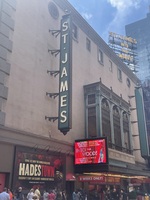 St. James Theater Built by and originally named after Broadway booking agent Abraham Erlanger, Erlanger's Theatre reportedly cost $1.5 million and opened with the musical The Merry Malones (https://www.playbill.com/venue/view-more?venue=00000150-aacd-d8be-af71-ffef1884000a). After Erlanger died in 1930, Lodewick Vroom acquired the theatre from the Astor family in 1932. The theatre had reverted to their ownership, as the original landowners, after Erlanger's estate defaulted on the rent. Vroom renamed the theatre after the St. James's Theatre in London. The Shuberts began operating the St. James through their subsidiary Select Theatres Corporation in 1941. In 1956 the Shuberts, who owned half of the theatres in New York City, were forced to sell the St. James as part of the ruling of a US federal antitrust case against them. The St. James became the first Broadway theatre operated by the newly formed Jujamcyn Theatres when Scarborough House Inc, purchased the theatre for $1.75 million in 1957 and leased it to Jujamcyn. The theatre was renovated in 1958 for $600,000, 1985 for $1.5 million, 1999 for $3 million, and 2016 (https://en.wikipedia.org/wiki/St._James_Theatre). It operated as a live theatre venue throughout its history. Notable productions: Oklahoma!, The King and I, Hello, Dolly!, The Who's Tommy, The Producers, Frozen, and Into the Woods (https://en.wikipedia.org/wiki/St._James_Theatre). Number of Seats: 1684 (https://www.playbill.com/venue/st-james-theatre-vault-0000000133) Both the facade and the auditorium interior are New York City landmarks. (https://en.wikipedia.org/wiki/St._James_Theatre)
St. James Theater Built by and originally named after Broadway booking agent Abraham Erlanger, Erlanger's Theatre reportedly cost $1.5 million and opened with the musical The Merry Malones (https://www.playbill.com/venue/view-more?venue=00000150-aacd-d8be-af71-ffef1884000a). After Erlanger died in 1930, Lodewick Vroom acquired the theatre from the Astor family in 1932. The theatre had reverted to their ownership, as the original landowners, after Erlanger's estate defaulted on the rent. Vroom renamed the theatre after the St. James's Theatre in London. The Shuberts began operating the St. James through their subsidiary Select Theatres Corporation in 1941. In 1956 the Shuberts, who owned half of the theatres in New York City, were forced to sell the St. James as part of the ruling of a US federal antitrust case against them. The St. James became the first Broadway theatre operated by the newly formed Jujamcyn Theatres when Scarborough House Inc, purchased the theatre for $1.75 million in 1957 and leased it to Jujamcyn. The theatre was renovated in 1958 for $600,000, 1985 for $1.5 million, 1999 for $3 million, and 2016 (https://en.wikipedia.org/wiki/St._James_Theatre). It operated as a live theatre venue throughout its history. Notable productions: Oklahoma!, The King and I, Hello, Dolly!, The Who's Tommy, The Producers, Frozen, and Into the Woods (https://en.wikipedia.org/wiki/St._James_Theatre). Number of Seats: 1684 (https://www.playbill.com/venue/st-james-theatre-vault-0000000133) Both the facade and the auditorium interior are New York City landmarks. (https://en.wikipedia.org/wiki/St._James_Theatre)